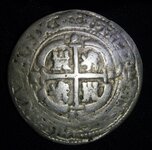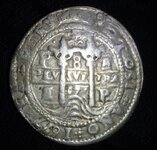While in Honduras in the early 1980's I picked up a handful of cobs and coins. On the way out of Honduras via Panama I had the opportunity to try and look up this 1677 coin in "Compendio de las Piezas de Ocho Reales", which I believe, at the time, was a leading authority on the early coins. My notes, which don't make a whole lot of sense to me some 25 years later state: Calbeto #1048 or 1049 (657 and/or 6577), rrr (extremely rare) or e (scare). I believe that we found a number of matches in the ID, but didn't find 100% of a match.
Does anyone have an idea on this reale and if so, what does it tell you? I was also wondering if I could be pointed in a direction for determining the market value?
I will post a few more pic's of some of the other coins I picked up at the same time.
Thanks for the help!
Pete
New Smyrna Beach, FL
Does anyone have an idea on this reale and if so, what does it tell you? I was also wondering if I could be pointed in a direction for determining the market value?
I will post a few more pic's of some of the other coins I picked up at the same time.
Thanks for the help!
Pete
New Smyrna Beach, FL










